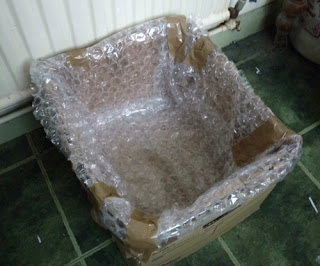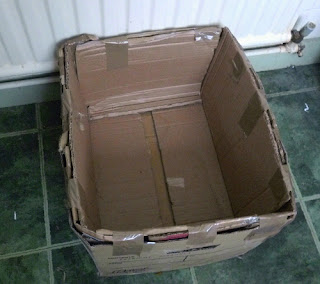I built my first version of the haybox about 4 years ago and based it on materials that we already had in the house and which were by-products of us working from home - cardboard boxes and shredded paper. My first simple construction was a large cardboard box filled with shredded paper. It was OK but not brilliant. I worked on improving the insulation in various ways and now seem to have a design that is energy efficient with components that can be replaced or cleaned as and when needed.
This is how the current shredded paper box is built.
The container is simply a large cardboard box with a second layer of cardboard placed inside. I found it impossible to find a second cardboard box that fitted easily, yet snugly, inside the first so I cut up the cardboard boxes we already had to line the first, and held the pieces in place with parcel tape.
Ideally, the cardboard should be corrugated as this provides an extra layer of insulation. If that is not available an intermediate layer of bubblewrap would do.
 The second step is to place a couple of layers of bubblewrap inside the box and, again, keep that in place with parcel tape.
The second step is to place a couple of layers of bubblewrap inside the box and, again, keep that in place with parcel tape. Prepare your food and start off your dish in a pan on the cooker as usual. When it is bubbling away nicely take it off the hob and bury it in the shredded paper.
Prepare your food and start off your dish in a pan on the cooker as usual. When it is bubbling away nicely take it off the hob and bury it in the shredded paper. For the lid I use an old feather pillow. Piling more shredded paper on top is too messy and, even if contained in something, it is not as good an insulated lid as the pillow.I found that it is best to use a waterproof pillow protector to stop the steam and smells from the simmering food getting through to the pillow itself. Otherwise you will be washing the pillow every few weeks to get rid of the pong and keep everything hygienic. Been there, done that!
For the lid I use an old feather pillow. Piling more shredded paper on top is too messy and, even if contained in something, it is not as good an insulated lid as the pillow.I found that it is best to use a waterproof pillow protector to stop the steam and smells from the simmering food getting through to the pillow itself. Otherwise you will be washing the pillow every few weeks to get rid of the pong and keep everything hygienic. Been there, done that!
Leave the casserole for several hours or overnight without peaking. You'll lose a lot of the heat if you do and you might let in undesirable micro-organisms that could thrive in the lowered temperature and contaminate the food.
A bonus with this method of cooking is that there is no need to keep an eye on the pan to make sure it doesn't dry out or start to burn. So, once it is in the box, you can go off and do something else.
Although some steam does escape from the pan most of it stays put. I found that the first few meat stews i made in the box had a lot of liquid left in them, which I either ladled off for soup or thickened with cornflour or chickpea flour. But reduce the amount you initially add to the pan by too much and the food is not completely covered by the liquid and does not cook through properly. With experience you get to know roughly how much liquid, if any, needs to be added.
I use the box for all sorts of meat and vegetarian casseroles, and thick soups and usually make enough for several meals. Once the pan is out of the box I bring it back to the boil and cook the food for a few minutes. I take out what I need for that day and the rest goes into airtight containers for the fridge and consumption later in the week. Easy to use, re-uses materials lying around the house and office, energy saving and labour saving. A winner all round.
A bonus with this method of cooking is that there is no need to keep an eye on the pan to make sure it doesn't dry out or start to burn. So, once it is in the box, you can go off and do something else.
Although some steam does escape from the pan most of it stays put. I found that the first few meat stews i made in the box had a lot of liquid left in them, which I either ladled off for soup or thickened with cornflour or chickpea flour. But reduce the amount you initially add to the pan by too much and the food is not completely covered by the liquid and does not cook through properly. With experience you get to know roughly how much liquid, if any, needs to be added.
I use the box for all sorts of meat and vegetarian casseroles, and thick soups and usually make enough for several meals. Once the pan is out of the box I bring it back to the boil and cook the food for a few minutes. I take out what I need for that day and the rest goes into airtight containers for the fridge and consumption later in the week. Easy to use, re-uses materials lying around the house and office, energy saving and labour saving. A winner all round.


No comments:
Post a Comment